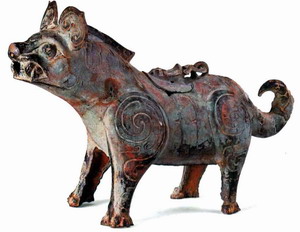5/6/2006
Animal Magic
Different venues, Hong Kong
The exhibition includes Neolithic pottery sculptures and jades, and bronzes and lacquers of the Chu and Han cultures. All exhibits feature the theme of humans and animals expressed in a harmonious relation.

Ancient Art from Jingzhou, Hubei Province
The Jingzhou Museum, Hubei province and the University Museum and Art
Gallery, The University of Hong Kong are pleased to present an exhibition of
excavated relics from the Jingzhou area of Hubei province, including
Neolithic pottery sculptures and jades, and bronzes and lacquers of the Chu
and Han cultures. All exhibits feature the theme of humans and animals
expressed in a harmonious relation.
Jingzhou, in southwestern Hubei province, was the location of the Chu
capital city Ji'nancheng during the Eastern Zhou period (770-221 BC), the
height of the Chu culture. By then its distinctive southern regional bronze
style of flamboyant form and decoration, and the portraying of real and
mythical images was established. This trait is best exemplified in the
"bronze tiger-shaped jun (wine container)" exhibited. Another exhibit
"bronze 'Bingbi Taisui' dagger-axe ge" is well-known for its representation
of the neighbouring exotic Ba-Shu culture to the southwest of the Chu state.
This is evidence of the cultural relationship between the Chu and Ba
cultures. On lacquer, a dou (stem bowl) with high relief designs of dragon,
phoenix and snake shows a scene of these three creatures fighting rarely
found among other Chu relics, manifesting the creative imagination of Chu
artisans.
As early as the Neolithic period (c. 6500-1500 BC), the three major ancient
cultures of Daxi, Qujialing and Shijiahe evolved in the area of Jingzhou.
Jade heads with realistic human features reveal the ancient human-based
psychology and ancestral worship. The jade flying eagle, jade tigers and
jade cicadas are representative of Shijiahe animal iconography imbued with
shamanic power, and were regarded with high esteem within Shijiahe culture.
Among the Neolithic pottery sculptures on display are "man holding fish"
figurines as evidence of the ancient fishery economy; and representations of
animals such as chickens, dogs, sheep, elephants and monkeys etc which were
presented as offerings during ceremonial and ritual practices.
The capital of the Chu culture at Jingzhou not only epitomises a magnificent
art tradition, but also plays a pivotal role in the shaping of Chinese
culture.
The opening ceremony will take place at the Museum on Tuesday 6 June at 6
p.m., with Mr YING Daiming, Mayor of Jingzhou, Ms YANG Yuhua, Deputy Mayor
of Jingzhou, Mrs Margaret Yu CHAN Chairman of The University of Hong Kong
Museum Society, and Professor Joseph LEE, Pro-Vice Chancellor of HKU as the
officiating guests.
The opening hours of the University Museum and Art Gallery are 9:30 a.m. to
6:00 p.m. Monday to Saturday, and 1:30 to 5:30 p.m. on Sundays. The Museum
is closed on public holidays. Admission is free. All are welcome.
Opening: Tuesday 6 June at 6 p.m.
Venues:
Umag
94 Bonham Road, Pokfulam - Hong Kong
Hours: Monday to Saturday 9:30 a.m. to 6:00 p.m. Sunday 1:30 to 5:30 p.m
*********************************************************************
The Jingzhou Museum
Hubei province - Hong Kong



